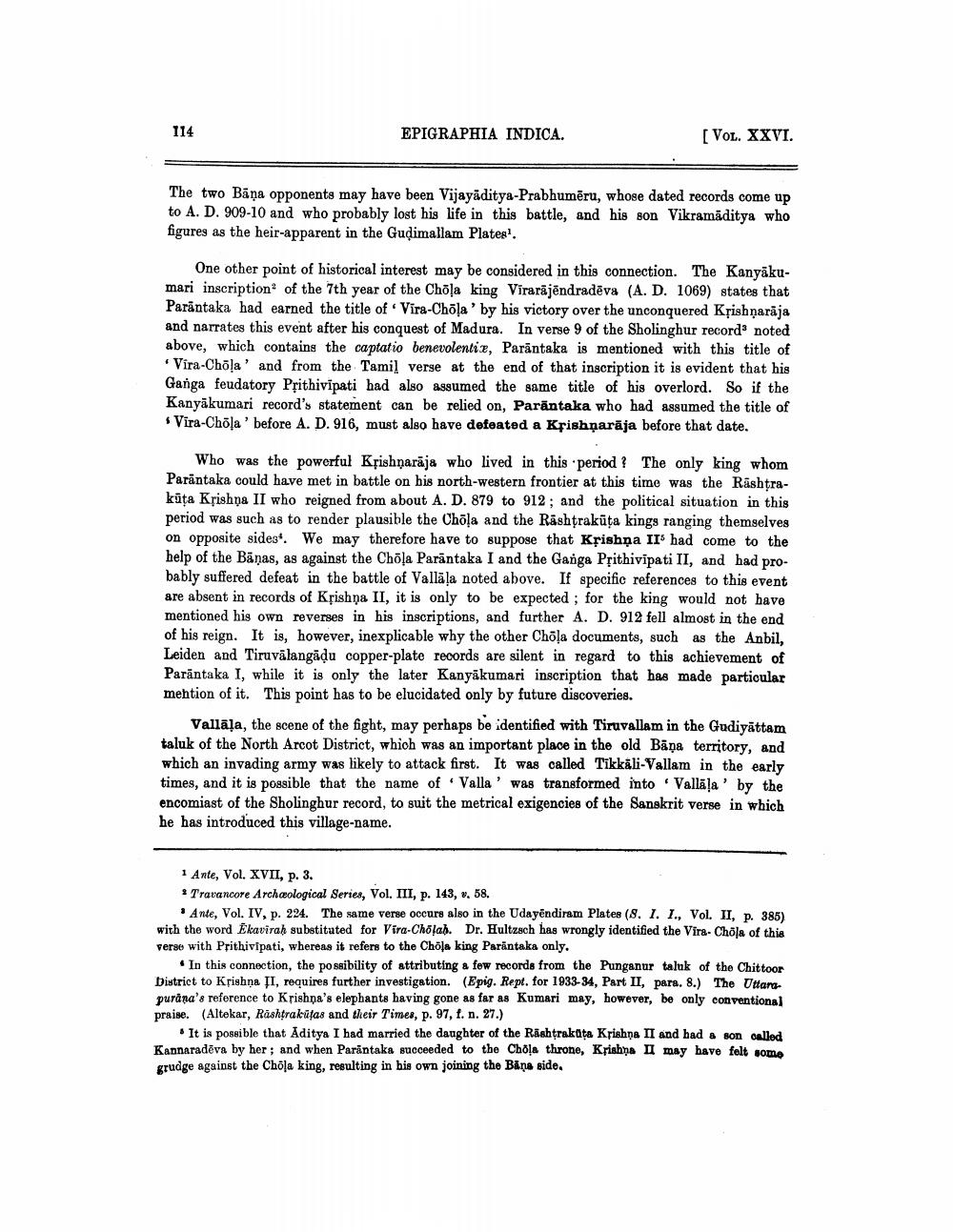________________
114
EPIGRAPHIA INDICA.
[VOL. XXVI.
The two Bana opponents may have been Vijayäditya-Prabhumēru, whose dated records come up to A. D. 909-10 and who probably lost his life in this battle, and his son Vikramaditya who figures as the heir-apparent in the Guḍimallam Plates1.
One other point of historical interest may be considered in this connection. The Kanyakumari inscription of the 7th year of the Chōla king Viraräjëndradeva (A. D. 1069) states that Parantaka had earned the title of Vira-Chōla' by his victory over the unconquered Krishnaraja and narrates this event after his conquest of Madura. In verse 9 of the Sholinghur record noted above, which contains the captatio benevolentix, Parantaka is mentioned with this title of Vira-Chōla' and from the Tamil verse at the end of that inscription it is evident that his Ganga feudatory Prithivipati had also assumed the same title of his overlord. So if the Kanyakumari record's statement can be relied on, Parantaka who had assumed the title of Vira-Chōla' before A. D. 916, must also have defeated a Krishnaraja before that date.
Who was the powerful Krishnaraja who lived in this period? The only king whom Parantaka could have met in battle on his north-western frontier at this time was the Rashtrakūta Krishna II who reigned from about A. D. 879 to 912; and the political situation in this period was such as to render plausible the Chola and the Rashtrakuta kings ranging themselves on opposite sides. We may therefore have to suppose that Krishna II had come to the help of the Banas, as against the Chōla Parantaka I and the Ganga Prithivipati II, and had probably suffered defeat in the battle of Vallala noted above. If specific references to this event are absent in records of Krishna II, it is only to be expected; for the king would not have mentioned his own reverses in his inscriptions, and further A. D. 912 fell almost in the end of his reign. It is, however, inexplicable why the other Chōla documents, such as the Anbil, Leiden and Tiruvalangaḍu copper-plate records are silent in regard to this achievement of Parantaka I, while it is only the later Kanyakumari inscription that has made particular mention of it. This point has to be elucidated only by future discoveries.
Vallala, the scene of the fight, may perhaps be identified with Tiruvallam in the Gudiyattam taluk of the North Arcot District, which was an important place in the old Bāņa territory, and which an invading army was likely to attack first. It was called Tikkäli-Vallam in the early times, and it is possible that the name of Valla' was transformed into Vallala' by the encomiast of the Sholinghur record, to suit the metrical exigencies of the Sanskrit verse in which he has introduced this village-name.
1 Ante, Vol. XVII, p. 3.
* Travancore Archaeological Series, Vol. III, p. 143, v. 58,
Ante, Vol. IV, p. 224. The same verse occurs also in the Udayendiram Plates (8. I. I., Vol. II, p. 385) with the word Ekaviraḥ substituted for Vira-Chōlab. Dr. Hultzsch has wrongly identified the Vira- Chōla of this verse with Prithivipati, whereas it refers to the Chōla king Parantaka only.
In this connection, the possibility of attributing a few records from the Punganur taluk of the Chittoor District to Krishna II, requires further investigation. (Epig. Rept. for 1933-34, Part II, para. 8.) The Uttara purana's reference to Krishna's elephants having gone as far as Kumari may, however, be only conventional praise. (Altekar, Rashtrakutas and their Times, p. 97, f. n. 27.)
It is possible that Aditya I had married the daughter of the Rashtrakuta Krishna II and had a son called Kannaradeva by her; and when Parantaka succeeded to the Chola throne, Krishna II may have felt some grudge against the Chola king, resulting in his own joining the Bana side.




